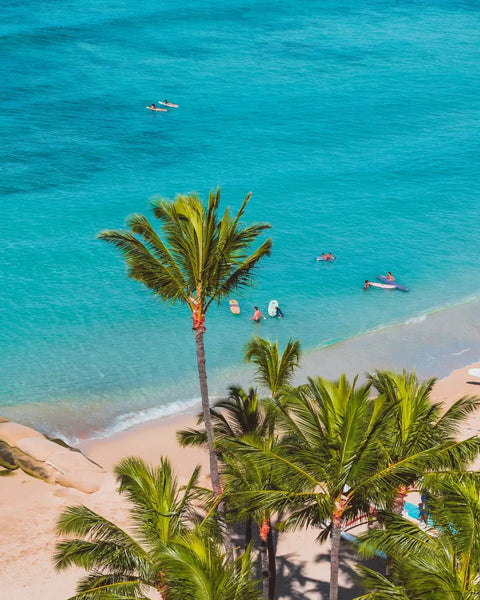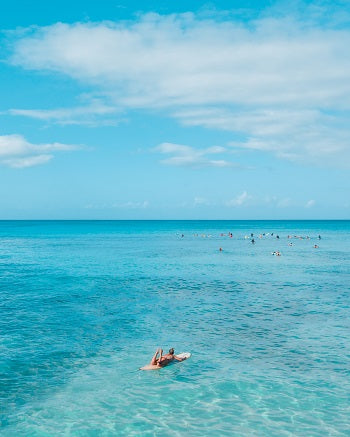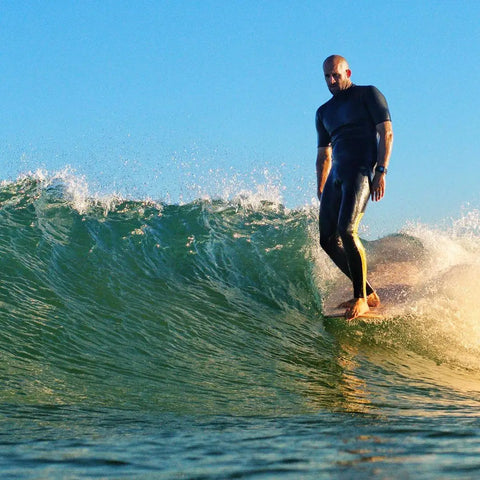Surf Etiquette
Share

Surf Etiquette
Written By: Matt Rode | Photo by Jess Vide
As most of us know, the complexities of surf etiquette can seem pretty overwhelming at times. But for those who understand how lineups work, there really shouldn’t be any confusion—so if someone is breaking etiquette, they are probably either ignorant or selfish. Let’s address ignorance first, and selfishness second.
Nearly all waves break in a specific direction—either left or right. (An obvious
exception would be Canoes in Waikiki, which is essentially a straight hander, and that’s why you often see 20 people on the same wave and they are all getting along great.) A-frame peaks like Pipeline and Backdoor break in both directions, but we tend to think of the two waves as separate entities, so Pipeline is a left and the other side of the peak at Backdoor is a right, and everything that follows applies to both separately.

In general, the surfer who is closest to the peak has priority or right of way. In other words, whoever is deeper gets the wave, because they can ride it the longest, and in most cases, they can get to their feet first. (If you don’t understand why only one person should be riding a wave, then you are likely very new to surfing, and you should limit yourself to waves like Canoes.)
This can get a bit confusing when guys are taking off behind the peak to backdoor a section, but in general, if you are paddling for a wave and look over your shoulder and someone is riding or taking off behind you, then it is their wave.
That being said, if everyone just paddled deeper than everyone else so that they could have priority, the lineup would be a pretty chaotic place, and eventually, everyone would jockey each other straight off of the peak. Thus, there are some understood etiquette rules that keep the lineup in order, and they are pretty darn obvious.
The most basic of these is that everyone needs to wait for their turn. Unless there are 100 people out on the peak, people usually know whose turn it is—or at the very least, where their relative place is in the lineup. When paddling out, you should assume that everyone who is already in the lineup before you has priority over you. If everyone follows that basic rule, then a revolving pecking order will naturally sort itself out. If only it were that simple.
Unfortunately, there are a bunch of variables that make surf etiquette more complicated than that. First of all, not everyone wants to surf every section of a wave. Some people are less comfortable taking off from deep, especially at heavier waves, and will hang out on the shoulder. If you are one of these people, then you may want to consider surfing a spot where you are more comfortable. Not only will you appreciate the wave more, but you are
surfers who are comfortable at heavier spots, and you are also less likely to get frustrated because you are never deep enough to have priority. Because even though the general rule is that everyone needs to wait for their turns, if someone is not riding from the peak of the wave, to some extent they give up whatever
priority they might have had.
Another variable is that some people wait for specific waves—whether big sets, or small inside runners, or waves that swing wide and hit the reef differently. Thus, there may be times when the surfer who has been waiting for the longest won’t choose to go on a wave. If that happens, then the surfer who has been waiting for the second-longest has priority, and so on and so forth.
Of course, it can become a bit difficult to keep track of everyone’s position in the priority line, which is why people tend to sit in order from the peak down toward the shoulder. When someone catches a wave, everyone behind them moves up farther toward the peak, and the lineup is maintained.
But those who are feeling greedy and selfish might think that they can just back-paddle the pack and sit deepest even if they haven’t been waiting the longest, and thereby usurp priority. This is not good etiquette, and it is generally frowned upon. While you might get away with it once or twice, if you continue to back-paddle and assume you have priority, you are eventually either going to get burned or get a talking to. Plus, you are generally just being a donkey, and no amount of wave count is going to make you feel better about being a donkey.
Now there are times when the people in the lineup may not be sitting in the right position, or may not be able to surf the wave to its full potential from the deepest, most critical section. If you paddle into this situation and find that the crowd is not sitting where you’d like to take off on the wave, it is permissible to paddle deeper, assuming a few things to be true.
First, you had better be a proficient enough surfer to actually surf the wave from where you are sitting. Second, just because you have paddled deeper than everyone doesn’t mean that you automatically have priority. The guys who you paddled past have still been waiting longer than you, so unless their positioning is going to make them miss the wave completely (ALL of them), you shouldn’t go just because you hold the inside position.
In fact, while you are paddling past the pack to your spot, it’s nice to give a friendly the explanation that you are paddling past them to surf from a deeper section of the wave, but that you know they have all been waiting, and that it is understood that they all still have priority over you. Then, once your turn is up—or if a wave comes through that you know for sure none of them will be in position to catch—you can get a wave from your spot.
While that beings to explain general surf etiquette, there are still a few more

layers to unravel here. First of all, if someone is surfing a wave that is above their skill level, and is repeatedly falling on the takeoff to the point where you can assume that they are not going to make the drop, it is acceptable to paddle for a wave they are going for and catch it after they have fallen. The same hold’s true if you see someone coming down the line from too deep, and you are certain they are not going to make the section and get to where you are taking off. But you want to be careful when making these assumptions, and err on the side of caution, because if they end up making the wave and you burn them, you are being a jerk.
Also, local lineups tend to have pecking orders made up of people who have put their time in and understand the wave intimately. This is a controversial subject with many people, because some feel that locals have earned the right to back-paddle or burn newcomers, while others believe that everyone has equal
rights to waves. In my opinion, it doesn’t matter if you have been surfing there for 50 years or 15 minutes, just as it doesn’t matter if you are the best surfer in the water or the worst—the general principle of sharing and taking your turn still applies. Any experienced surfer knows when they are being a wave hog, and again, you aren’t making anyone’s day better by acting like that—yours included.
That being said, people who are new to surf spots should respect the fact that

others have been surfing there for a long time, and that they may have a better understanding of the wave. So when you approach a new spot, do so slowly. Watch from the shoulder for a few minutes, get a feel for where everyone is sitting and whose turn it is, and then slowly integrate yourself into the rotation. Don’t just paddled out and go straight to the top of the peak, because not only does that make you a greedy jerk, but you also aren’t going to make any friends. In fact, you might just get yourself sent in.
Finally, we have the issue of shortboarders and longboarders/SUPs. Some people think that longboarders shouldn’t be surfing “shortboard waves,” and I’ve actually seen someone yell at shortboarders for surfing a “longboard wave.”
Personally, I believe that it is more important to make an honest evaluation of your abilities as a surfer. There are longboarders and SUP surfers who can surf high-performance waves or charge Pipeline as well as those on more conventional craft, just as there are those who rip apart traditional logging waves like Malibu on shredsticks. If you are surfing within your ability level, then I believe it’s okay to surf a longboard at a “shortboard spot.” But that doesn’t mean it’s okay to be a wave hog. Just because you can paddle into waves earlier than everyone else in the lineup doesn’t mean that you have infinite priority. It all comes back to the general rule of waiting your turn. No matter what you are riding, take stock of the lineup, figure out your place in it, and wait until your number is up.
Even if you are a professional surfer sharing the lineup with a bunch of beginners, there is no reason to be a pig. The bottom line is that just because you can take a wave doesn’t mean you should. Take turns and share waves, and you just might find that it’s as enjoyable to see someone else score as it is to ride one yourself.
More to Read...
- How to Survive Wipeouts & Hold Downs
- How to Paddle Out
- Swells 101: How Are Waves Formed?
- Fuel for Athletes: The Delicious Benefits of Oatmeal
- How to Prepare for a Big Swell - Matt Rott

